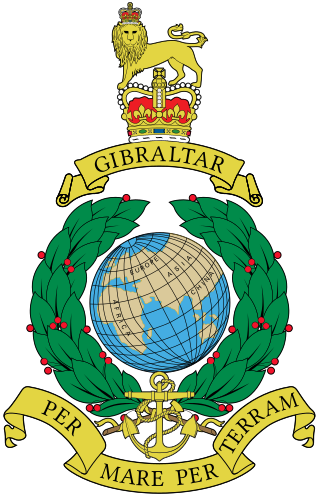
The Royal Marines, also known as the Royal Marines Commandos, and officially as the Corps of Royal Marines, are the United Kingdom's amphibious special operations capable commando force, one of the five fighting arms of the Royal Navy, and provide a company strength unit to the Special Forces Support Group (SFSG). The Royal Marines trace their origins back to the formation of the "Duke of York and Albany's maritime regiment of Foot" on 28 October 1664, and the first Royal Marines Commando unit was formed at Deal in Kent on 14 February 1942 and designated "The Royal Marine Commando".
This is a list of British ground forces in the Falklands War. For a list of ground forces from Argentina, see Argentine ground forces in the Falklands War

An artillery observer, artillery spotter, or forward observer (FO) is a soldier responsible for directing artillery and mortar fire support onto a target. An artillery observer usually accompanies a tank or infantry unit. Spotters ensure that indirect fire hits targets which those at a fire support base cannot see.
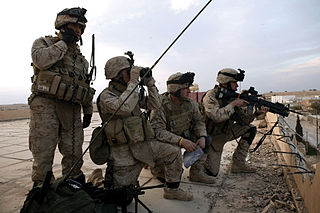
Air Naval Gunfire Liaison Company (ANGLICO) is an airborne fire support and liaison unit of the United States Marine Corps. The mission of ANGLICO is "To provide Marine Air-Ground Task Force (MAGTF) Commanders a liaison capability to plan, coordinate, and conduct terminal control of fires in support of joint, allied, and coalition forces. Per this mission statement, ANGLICOs are not designed to support U.S. Marine Corps maneuver elements. Instead, the doctrinal purpose of ANGLICO is to provide fire support and coordination in support of units adjacent to the MAGTF.

29 Commando Regiment, Royal Artillery is the Commando-trained unit of the British Army's Royal Artillery, based in Plymouth. The regiment is under the operational control of 3 Commando Brigade, to which it provides artillery support and gunnery observation.
The role of the Commando Logistic Regiment (CLR), Royal Marines is to provide second line Combat Service Support to 3 Commando Brigade.
The history of the Royal Marines began on 28 October 1664 with the formation of the Duke of York and Albany's Maritime Regiment of Foot soon becoming known as the Admiral's Regiment. During the War of the Spanish Succession the most historic achievement of the Marines was the capture of the mole during the assault on Gibraltar in 1704. On 5 April 1755, His Majesty's Marine Forces, fifty Companies in three Divisions, headquartered at Portsmouth, Chatham and Plymouth, were formed by Order of Council under Admiralty control.

Special reconnaissance (SR) is conducted by small units, such as a recon team, made up of highly trained military personnel, usually from special forces units and/or military intelligence organizations. Special reconnaissance teams operate behind enemy lines, avoiding direct combat and detection by the enemy. As a role, SR is distinct from commando operations, but both are often carried out by the same units. The SR role frequently includes covert direction of airstrikes and indirect fire, in areas deep behind enemy lines, placement of remotely monitored sensors, and preparations for other special forces. Like other special forces, SR units may also carry out direct action and unconventional warfare, including guerrilla operations.
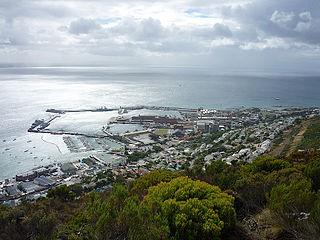
South Africa currently does not have a marine corps, though in the past it did. It was originally set up as a sub-branch of the South African Navy during the apartheid era, with the primary purpose of protecting the country's harbours (1951-1955). Then it was recreated in 1979 during the South African Border War as 1 Marine Brigade with the aim of serving as marine infantry (1979-1990). Today, the SAN Maritime Reaction Squadron is the closest analogue to a marine corps South Africa has.
N Parachute Battery Royal Horse Artillery is a Tactical Group Battery of 7th Parachute Regiment Royal Horse Artillery. They are currently based in Merville Barracks Colchester, home of 16 Air Assault Brigade Combat Team.
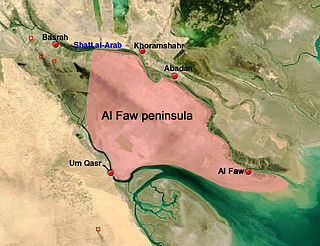
The Battle of Al Faw was one of the first battles of the Iraq War; it took place March 20-24, 2003.

Camp Dwyer was a military camp formerly of the United States Marine Corps located within the Helmand River Valley southwest of Garmsir in Garmsir District, Helmand Province, Afghanistan.
Forward observers in the U.S. military are artillery observers who carry the Military Occupational Specialty designator of 13F in the United States Army and 0861 in the United States Marine Corps. They are officially called Joint Fire Support Specialists in the U.S. Army and Fire Support Marines in the U.S. Marine Corps. They are colloquially known as FiSTers, regardless of whether they are members of a FiST. The Battalion Fire Support Officer (FSO) is the Officer in Charge of a Battalion Fire Support Element.
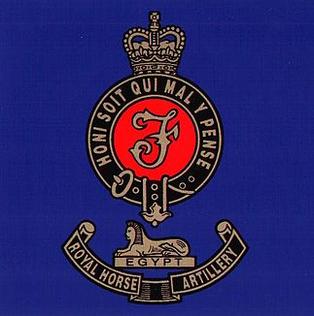
F (Sphinx) Parachute Battery Royal Horse Artillery is a close support battery of 7th Parachute Regiment Royal Horse Artillery, part of the Royal Horse Artillery of the British Army, currently based in Merville Barracks in Colchester.
In 1989 the Royal Navy was under the direction of the Navy Department in the UK Ministry of Defence. It had two main commands, CINCFLEET and Naval Home Command.

The 100th (Yeomanry) Regiment, Royal Artillery, formerly the National Reserve Headquarters, Royal Artillery is an Army Reserve administrative group of the Royal Artillery which oversees the recruitment and maintaining of specialist reserve units and personnel.

The Fire Support Command is the artillery arm of the Royal Netherlands Army. The command consists of 41 Artillery Battalion, a staff, the Fire Support School and the artillery training grounds and is part of the Operational Support Command Land.










